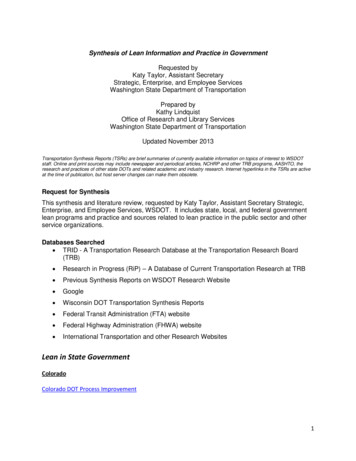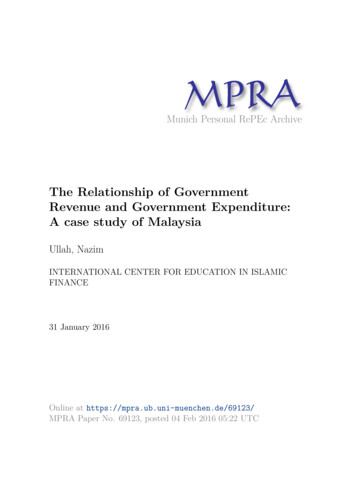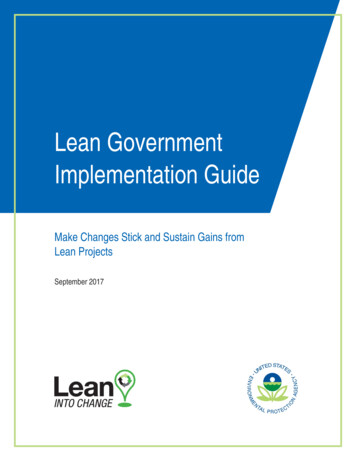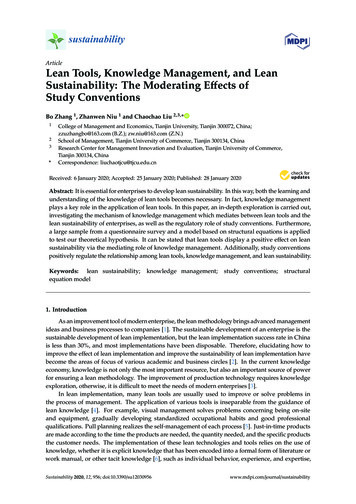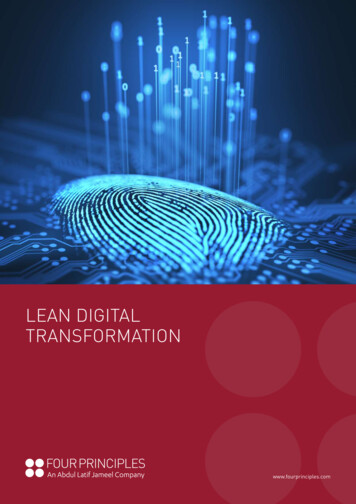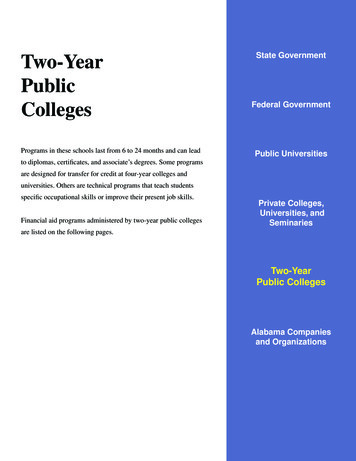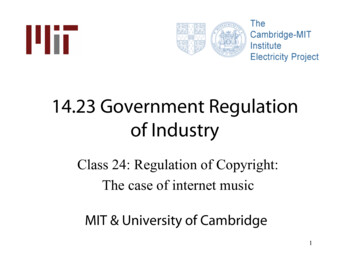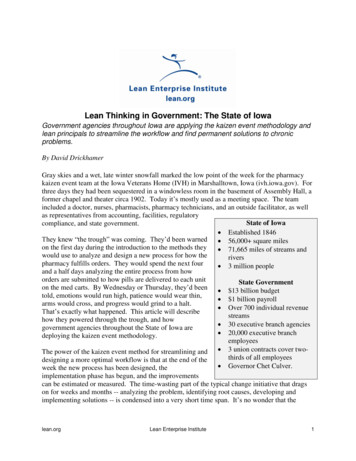
Transcription
Lean Thinking in Government: The State of IowaGovernment agencies throughout Iowa are applying the kaizen event methodology andlean principals to streamline the workflow and find permanent solutions to chronicproblems.By David DrickhamerGray skies and a wet, late winter snowfall marked the low point of the week for the pharmacykaizen event team at the Iowa Veterans Home (IVH) in Marshalltown, Iowa (ivh.iowa.gov). Forthree days they had been sequestered in a windowless room in the basement of Assembly Hall, aformer chapel and theater circa 1902. Today it‟s mostly used as a meeting space. The teamincluded a doctor, nurses, pharmacists, pharmacy technicians, and an outside facilitator, as wellas representatives from accounting, facilities, regulatoryState of Iowacompliance, and state government. Established 1846They knew “the trough” was coming. They‟d been warned 56,000 square mileson the first day during the introduction to the methods they 71,665 miles of streams andwould use to analyze and design a new process for how theriverspharmacy fulfills orders. They would spend the next four 3 million peopleand a half days analyzing the entire process from howorders are submitted to how pills are delivered to each unitState Governmenton the med carts. By Wednesday or Thursday, they‟d been 13 billion budgettold, emotions would run high, patience would wear thin, 1 billion payrollarms would cross, and progress would grind to a halt. Over 700 individual revenueThat‟s exactly what happened. This article will describestreamshow they powered through the trough, and how 30 executive branch agenciesgovernment agencies throughout the State of Iowa are 20,000 executive branchdeploying the kaizen event methodology.employees 3 union contracts cover twoThe power of the kaizen event method for streamlining andthirds of all employeesdesigning a more optimal workflow is that at the end of the Governor Chet Culver.week the new process has been designed, theimplementation phase has begun, and the improvementscan be estimated or measured. The time-wasting part of the typical change initiative that dragson for weeks and months -- analyzing the problem, identifying root causes, developing andimplementing solutions -- is condensed into a very short time span. It‟s no wonder that thelean.orgLean Enterprise Institute1
natural anxiety and resistance to any change in how people do their jobs would be condensed aswell.Of course there are always homework items that cannot be resolved during the initial week.These are addressed at 30-, 60- and 90-day review meetings. In the case of the pharmacy orderfulfillment event, the new process wouldn‟t be fully rolled out until the beginning of July; threemonths after the kaizen event took place in late March. It took that much time to redesign theworkflow in the pharmacy itself, to train nurses, aids and others touched by the process, and toget everyone to buy into the new way of doing things. Some of the steps and procedures thatwere eliminated had been in place for years, even decades.At a Glance: Iowa Veterans Home Iowa Veterans Home (IVH) in Marshalltownaccepts its first resident on Dec. 1, 1887Today, with over 700 beds, IVH is the thirdlargest State Veteran‟s Home in the United States.The facility offers nursing, medical, rehabilitativecare, and mental health services. It operates itsown on-site pharmacy. Doctors are available 24hours a day, seven days a week.“One thing we do very well here,” saysCommandant Daniel Steen, who headsup the facility, “every time there is aproblem, we find a system to fix thatone problem. Imagine the number oftimes over the years that there mighthave been a problem getting aprescription from the doctors‟prescription sheets to a bottle to thenurse putting the pill in someone‟smouth. We‟ve developed systems andfail-safes to eliminate everything thathas ever gone wrong.”The problem with such rules and their enforcement, he says, is that they don‟t always take intoconsideration the needs of the residents. Compounding the problem, especially at a facility likethe Iowa Veterans Home with multiple care wings and buildings, such fixes can evolveindependently in different areas. This makes it more difficult for people -- like the certified aidswho help dispense medications to IVH residents -- to move from one building to another withouthaving to learn a different process, which increases the opportunities for error.“One of the things that I like about the kaizen process is how it spends a lot of time on valueadded. The team asks, „What is the value of this step? Is this something that we really need todo?‟ ” Steen adds.Taking people away from their regular job for a week requires a major commitment. But Steencompares it to having two standing committees and a study group that meets once a month towork on a problem, sometimes for years, without ever finding a solution. Or the high cost ofhaving outside consultants come in, interviewing people, looking at everything that you aredoing and putting their solution into a fancy report that ends up sitting on a shelf.“I wish I‟d known about this process 30 years ago,” he says.Led by skilled facilitators, and bound together by their common concern for the residents, thekaizen pharmacy team worked their way out of the trough. First, they separated into smallergroups to work out solutions within the parameters established during the scoping discussionslean.orgLean Enterprise Institute2
prior to the event. The whole team then documented the agreed upon process changes withsticky notes and red arrows affixed to a mural-sized sheet of paper stretching around the room.They eliminated steps that added time and effort but didn‟t reduce the opportunity for errors orthat didn‟t serve residents‟ needs. The new process, which fully unfolded over the comingmonths, trimmed the number of steps from 124 to 91, cutting delays and handoffs by 69%.A New Definition of the CustomerEverything at the Iowa Veterans Home starts and ends with the residents. The facility housesover 700 U.S. military veterans and their spouses. They are cared for by a staff of 950 nurses,doctors, aids, administrators, maintenance workers and other employees who tend to theresidents‟ needs 24 hours a day, 7 days a week, 365 days a year.The Performance Improvement Department at IVH divides its resources between processimprovement, regulatory compliance, safety management, and medical records/HIPAAcompliance. A Quality Council provides a communication link between departments and seeksinput from residents and staff in making care change decisions. Process Action Teams look atimprovement issues for the living and working environment, as well as agency widepolicies/issues and new initiatives.For the past three years the site has been using the lean kaizen event methodology to find andimplement solutions to processes that span multiple departments and functional silos. They havetackled the medication administration process, a painstaking process when all residents on eachwing must receive their prescriptions within a two-hour window. They‟ve worked on howmaintenance prioritizes work orders and the admission process itself.Unlike lean initiatives in the business world, the ultimate goal isn‟t to boost profit margins,although costs and revenues are a priority. For example, billing improvements stemming fromthe pharmacy order fulfillment event would eventually improve the prescription reimbursementrate (an important source of revenues) from the Veterans Benefits Administration. Still, theultimate goal is to improve residents‟ quality of care and quality of life.To this end IVH will break ground in March 2009 on a multi-phase, 100-million constructionproject. When its complete residents will move from an institutional, hospital-like setting into amore home-like atmosphere where the day is less structured and that encourages moreindependent living. Reflecting a movement in the healthcare and nursing home industry toward“patient-centered care,” the new facilities will feature private rooms and warmly decoratedcommon areas with full kitchens. This transition is not unlike the move in lean factories awayfrom efficiency focused, batch processes and toward more demand-driven products and services.Anticipating the depth of the culture change required to take full advantage of the newenvironment, the most recent kaizen event at IVH focused on how these new care facilitieswould be managed. Prior to this design event, so they could get a feel for the new culture andwork procedures, members of the team visited a nearby nursing home that has already moved toa less traditional structure. As they discovered, one of the major benefits of the new approach toresident care is the positive impact it can have on the satisfaction levels of both residents andemployees. As healthcare operations around the country struggle to find qualified workers andlean.orgLean Enterprise Institute3
manage turnover, the non-traditional facility that they visited had a waiting list of people wantingto work there.Considering the setup of the new buildings, as well as several employee and resident surveys, theLean design team brainstormed and plotted the anticipated process changes on a two-by-twoimpact/difficulty matrix. They focused on the sweet spot of that matrix, on those initiatives thatwill require the least effort but could have the greatest impact. Not waiting for construction to becomplete or even to begin, they then began to develop an implementation plan for how thesechanges could be implemented within a pilot area of an existing facility.“Even though they were designing a new process, the team still experienced a trough halfwaythrough the event,” says Ann Hogle, a management analyst in the performance improvementdepartment, who helped facilitate the design event. “There‟s just this huge gap between how wedo things now in an institutional setting and the goals we were looking at in the ideal state. Itwas difficult to see how we were ever going to get there.”Staffing requirements, for example, will be different with residents living in 15-unit“households” where everyone isn‟t being woken up at the same time every morning to receivebreakfast and their medications. The staff itself will have to be organized more by household,and less by functional job roles, requiring them to be more cross-trained. One of the innovativeapproaches that they are considering, Hogle notes, is involving the household residentsthemselves in the hiring process for open positions in their areas. In many aspects the thinkingbehind this resident-centered approach to veterans care mirrors changes at the state level in howgovernment should be structured to serve all Iowans.Iowa Veteran’s Home Kaizen Events2005 Medication Administration 8 hours reduced to 4 hours2006 Maintenance Work OrdersSteps reduced by 62%;hand-offs reduced by 58%Medical AppointmentsDelays reduced 79%;steps reduced 66%AdmissionsDelays reduced 86%;steps reduced 62%2007 Medication Administration Delays reduced 69%;steps reduced 49%;decisions reduced 81%;handoffs reduced 57%2008 Pharmacy ProcessDelays reduced 68%;steps reduced 27%;decisions reduced 58%;handoffs reduced 69%Patient-Centered CareDesigned how care will bedelivered in new householdbased buildings.lean.orgLean Enterprise Institute4
Sowing the Seeds of ChangeThe Iowa Veterans Home was one of six state government departments (out of 30) that elected tobecome Iowa Charter Agencies in July 2003. Part of a statewide effort to reduce bureaucracythat was introduced by then Governor Tom Vilsack, the leaders of the Iowa Charter Agenciespledged to deliver measureable performance improvements and annual cost savings in exchangefor flexibility with regard to administrative rules and an exemption from state staffing limits andacross-the-board budget cuts.Previously, for example, in order to travel to an out-of-state medical conference a doctor at IVHhad to follow a time-consuming cost justification process, applying and receiving approval fromthe state government in Des Moines. Under the Charter Agency program, such requests could bereviewed and approved on site by the Commandant.The Charter Agency initiative, which won a government innovation award from the KennedySchool of Government at Harvard University, was one of several initiatives launched around thistime for reinventing how Iowa government works. These programs provided the foundation forthe discovery and adoption of lean methodologies. The local business community played apivotal role as well.Iowa‟s lean journey officially began in 2003 when they launched their first kaizen event at theDepartment of Natural Resources‟ to fix the process for reviewing and issuing air quality newsource construction permits. Members of the Iowa Business Council funded the event, pickingup the fees to bring in an experienced kaizen event facilitator from Guidon PerformanceSolutions, a TBM Consulting Group company.At the time DNR issued around 2,000 such permits per year. Before the kaizen event took placeit took an average of 62 days to get a new permit approved. Before it could begin, organizershad to overcome staff concerns that this was another tool to cut jobs—the agency made a pledgethat no one would be out of work as a result of any process changes—and that it was just abusiness-driven effort to undermine environmental protections. In the end the kaizen teamreduced the permit cycle time down to six days, without changing any regulatory or compliancerequirements, and eliminated a 600-application backlog over the next six months.“The support of our private sector partnership has been tremendous,” says Teresa HayMcMahon, performance results director for the Iowa Department of Management. “They haveprovided training and allowed us to send people to participate in events at their facilities.They‟ve mentored us from day one. When I talk to other states they‟re jealous of the guidanceand support that we‟ve had from the business community.“We would not have received the funding for a full-time employee to establish the Office ofLean Enterprise within the state government if it hadn‟t been for our private sector partners‟work in taking it to the legislature,” she adds. Similar results to the initial DNR project havebeen replicated in subsequent kaizen events (See table, “The State of Iowa‟s Lean Journey”).Slowly, event by event, these efforts have overcome objections that lean tools and approacheswouldn‟t work in a government setting.lean.orgLean Enterprise Institute5
Iowa State Government Kaizen EventsSponsoring DepartmentDept of Natural ResourcesDept of Public SafetyIowa Veterans HomeDept of Cultural AffairsDept of Human ServicesIowa Workforce DevelopmentDept of Economic DevelopmentDept of Administrative Services, HumanResources EnterpriseIowa Finance AuthorityAlcoholic Beverages Division (Dept ofCommerce)Dept of Inspections & AppealsDept of CorrectionsDept of ManagementBoard of Medical ExaminersDept of Public HealthDept of Administrative Services, GeneralServices EnterpriseIowa Board of Educational ExaminersIowa Communications NetworkIowa Civil Rights CommissionIowa Dept of RevenueIowa LotteryIowa Vocational Rehab ServicesOffice of Energy IndependenceProfessional Licensing Bureau (Dept. ofCommerce)Total(Source: lean.iowa.gov/results.html, g the impact of theseimprovements from the perspective ofIowa‟s citizens hasn‟t always been easy.Yes, many behind-the-scene steps,handoffs, and delays have beeneliminated. Permits of all types areprocessed faster today. Arson cases arebeing investigated more effectively.Employee grievances are resolvedquicker. All of this is well and good, butwhat are the hard dollar savings?When asked that question, McMahonrecalls a conversation with a formerdirector of the Department ofCorrections. The year before they hadconducted a kaizen event that addressedthe process for managing offender‟s reentry into the community. TheDepartment of Corrections implementeda new process that begins at the initialpoint of incarceration, when statepersonnel at the medical andclassification center evaluate offendersto determine what medical treatmentthey may require and where they will beheld. At that moment they startpreparing people for the day when theywill be released back into thecommunity. Working to improve thatprocess, according to the agencydirector, had fundamentally altered boththe mindset of the staff as well as theoffenders.“How do you put a price tag on that? Onchanging the offender‟s mindset?” Sheasks.Ground SupportMost of the 90-plus kaizen events that the state has conducted have been facilitated by outsideconsultants. In 2006 the legislature approved funding to establish the Iowa Office of LeanEnterprise within the Dept. of Management. And in 2007 they hired their first full-time leanstaff person, Mike Rohlf, to help coordinate efforts and lead some of the kaizen events. In thefall of 2008 they were working on adding a second full-time member to the State‟s lean team.lean.orgLean Enterprise Institute6
“If you‟re really going to make lean the way you do business, you have to be able to do ityourself. You can‟t rely on external consultants,” says McMahon. Citing the experience of theirprivate sector partners, she acknowledges that developing such expertise can take a fair amountof time. Kaizen event facilitators at their business partners often participate in 20 or more eventsbefore leading one on their own. “Some of those troughs can be really deep. You don‟t want togo in there, get a team down in the trough and not know how to get them back out of it,” sheexplains.Many people who choose to work in government do so because they want to commit themselvesto a higher purpose. They may care deeply about the treatment of foster children, or want toprotect the environment. Such feelings of ownership can intensify the emotions that can eruptwhen such services and activities are analyzed during a kaizen event.Jim Scott, a senior consultant with Guidance Performance Solutions who facilitated thepharmacy event at the Iowa Veterans Home, has participated in many of Iowa‟s most difficultevents. These typically span multiple departments that may have a history of blaming oneanother for problems. Scott says that he lives for the troughs because that‟s when the teamsreally start to embrace the changes that they are initiating, and he takes extra enjoyment fromworking with government organizations.“It‟s not just about reducing steps or cutting costs, although those are important. It‟s aboutimproving people‟s lives. That offers a whole additional layer of satisfaction,” says Scott.Sustaining the MomentumAfter five years and 33 kaizen events, McMahon says that the Iowa Department of NaturalResources is furthest along in to adopting a lean culture focused on eliminating waste andimproving flow. Staff members have participated in multiple events. They have built up faith inthe process based on a steady track record of breakthrough results, and are actively offeringsuggestions for future projects.Being disciplined about the follow-up work following each event has been critical to sustainingtheir momentum, she notes. Program leaders have to be disciplined about scheduling the 30-,60- and 90-day meetings to find out if things are moving forward as planned, and to establishnew due dates for tasks that fall behind schedule. Another critical element to sustainment iseffective sponsor support (See, “Lean Government Resources.”) The sponsors, who sign acontract at the outset of each event, are responsible for removing barriers and allocatingresources so that the work can get done.During the early years, Iowa‟s kaizen events tackled the most obvious pain points, obviouslybroken processes that were causing a lot of headaches. Today, according to McMahon, they‟reprioritizing more projects based on strategic objectives. They‟ve held a number of strategicpolicy deployment events in different agencies to identify those areas that, if improved, wouldhave the biggest impact on agency performance over the next year or two. Like similar projectsin the business world, the cross-functional teams have created organization-wide value streammaps to pinpoint bottlenecks and improvement opportunities. The ultimate goal is to touchevery process in every agency of the executive branch.lean.orgLean Enterprise Institute7
“The thing that‟s unique about Iowa is that we made an enterprise-wide commitment. Thishasn‟t been just one agency. It‟s become a permanent part of our government,” says McMahon.Other than the sheer number of completed and scheduled kaizen events, another indicator thatthe state‟s lean efforts have entered a more mature phase is the establishment of the LeanGovernment Collaborative in January 2008. Rather than rely on their private sector partners toschedule and host their joint quarterly meetings, which they‟d been doing since 2004, the IowaDepartment of Management has now taken over this responsibility. This is not to say that thosebusiness advisors are becoming any less involved. As McMahon relates, “When it comes to leanwe‟ve really just stood up now, kind of like a baby that‟s learning to walk and has grabbed theside of a coffee table. We‟re absolute newbies at this, and still have so much to learn.”Progress ReportEvery kaizen event closes with a report out by the teams detailing the new processes that they‟vedesigned. One of the purposes of this meeting is to publicly recognize the efforts of the teammembers. It also lays the groundwork for getting buy-in from everyone else in the organizationtouched by the changes who wasn‟t involved in the event itself.Jim Scott, in his role as facilitator, offered some words of encouragement at the Friday report outfor the pharmacy event in the crowded auditorium of the Assembly Hall. “When the individualson this team really mapped out the process, one of the things that they said was, „We now have amuch greater appreciation for what it really takes to get an order in and order out. It‟s not aseasy as it looks,‟” he said.“Change is easy to talk about. It‟s difficult to do,” he continued. “Change forces us to reallylook at ourselves, and determine whether we‟re going to accept and live with the change, orresist it . This team has made a commitment to work out and change the processes in thepharmacy. I‟m asking all of you to make the same commitment while they try to roll this out.They need your help and your support.”Following their individual presentations, before emerging into bright blue skies and the slushyremains of the previous day‟s snowfall, the pharmacy kaizen team members headed back downto the basement conference room with their colleagues to review the current and future stateprocess maps. They answered questions and explained the changes that would have to occurwith obvious pride in what they‟d accomplished, knowing full well that a lot of work remainedto be done.The State of Iowa’s Lean JourneyJune 1, 2001Iowa Governor Tom Vilsack signsThe Act institutionalizes strategicAccountable Government Act into planning, annual performancelawplanning, performancemeasurement, results-basedbudgeting, audits, and ROImeasures for all governmentagencies.January 2002 Iowa Business Council establishes ICIG objective to move the statelean.orgLean Enterprise Institute8
September2002June 2003July 2003December2003December2003June 2004June 2005July 2005August 2005lean.orgIowa Coalition for Innovation &Growth (ICIG)Iowa Reinvention Partnershipestablished between Iowa Dept. ofManagement and The PublicStrategies Group(transformiowa.org)ICIG Lean “Hot Team” funds akaizen event at the Iowa Departmentof Natural Resources to fix theprocess for issuing air quality newsource construction permitsGovernor Tom Vilsack establishesCharter Agencies(charter.iowa.gov)ICIG Lean Hot Team becomes aprivate/public partnership, invitesstate government to join quarterlymeetings to transfer continuousimprovement knowledge and leanexperience to the leaders of stategovernment agencies.Results Iowa website launched(www.resultsiowa.org)forward in economic growth.Four “Hot Teams” created.State leaders make a commitmentto transform how governmentworks.Permit time decreases from 62months to 6 working days,backlog of 600 applicationseliminated in six monthsSix state government agenciespledge to enhance efficiency,eliminate bureaucracy andimprove servicesKey members: Pella Corp.,Rockwell Collins, AlliantEnergy, EDS, Wells Fargo,John Deere & Co.Website summarizes quarterlyperformance by department:what‟s improved, what hasn‟t,and what state government isdoing to improve results.Three kaizen events conductedIowa Coalition for Innovation &during the 2004 fiscal year ending in Growth shows stateJuneadministrators how lean tools canbe applied to governmentprocesses.18 kaizen events conducted duringthe 2005 fiscal yearCharter Agencies win InnovationsSponsored by the KennedySchool of Government atin Government AwardHarvard University, the awardrecognizes agency efforts to savemoney by reducing expenditureand increasing revenues inexchange for more flexibility andauthority.Iowa Governor Tom Vilsackannounces that all governmentagencies will support lean andLean Enterprise Institute9
June 2006July 2006November 7,2006June 2007October 2-4,20072007January 2008June 2008October 2008conduct at least one kaizen event22 kaizen events conducted duringthe 2006 fiscal year ending in JuneIowa Office of Lean Enterprisereceives funding within theDepartment of Management(lean.iowa.gov)Governor Tom Vilsack (D) decidesnot to seek reelection, Chet Culver(D) wins general election25 kaizen events conducted duringthe 2007 fiscal year ending in JuneLean Government Exchange;Governor Chester J. Culver declaresOctober 2, 2007, Lean GovernmentDayIowa Dept. of Management hiresfirst full-time lean staffLean Government Collaborativeformed with six private companiesand six state agencies19 kaizen events conducted duringthe 2008 fiscal year ending in JuneIowa Dept. of Management hiressecond full-time lean coordinator tohelp manage and facilitate kaizeneventsState government transformationand lean initiatives surviveleadership transitionWorkshop is hosted jointly by theState of Iowa and GuidonPerformance Solutions withparticipation by 70 peoplerepresenting twenty states andfederal agenciesIowa Dept. of Management takesover the leadership role ofpublic/private lean partnershipfrom the business coalitionTo date 95 formal kaizen eventshave been conducted withinexecutive branch agencies acrossthe state.Glossary(Adapted from the Lean Lexicon, available in printed and electronic versions)KaizenContinuous improvement of an entire value stream or an individual process to create more valuewith less waste. There are two levels of kaizen: (1) System or flow kaizen focuses on the overallvalue stream and (2) process kaizen focuses on individual processes.Kaizen WorkshopA group kaizen (continuous improvement) activity, commonly lasting five days, in which a teamidentifies and implements significant improvements in a process. After improvements, theprocess is standardized and the kaizen team reports out to senior management.Value Streamlean.orgLean Enterprise Institute10
All of the actions, both value creating and nonvalue creating, required to bring a product fromconcept to launch and from order to delivery. These include actions to process information fromthe customer and actions to transform the product on its way to the customer.Value-Stream MappingA simple diagram of every step involved in the material and information flows needed to bring aproduct or service from order to delivery. Value-stream maps can be drawn for different points intime as a way to raise consciousness about opportunities for improvement. A current-state mapfollows the path from order to delivery to determine the current conditions. A future-state mapdeploys the opportunities for improvement identified in the current-state map to achieve a higherlevel of performance. In some cases, it may be appropriate to draw an ideal state map showingthe opportunities for improvement by employing all known lean methods including right-sizedtools and value stream compression.For More InformationLean in Government Resources: To help other government agencies, the State of Iowa hasmade publicly available at http://lean.iowa.gov/resources.html many of the materials that it hasfound useful in executing its lean initiatives, including: Team Charter: Sets out the scope of the process that will be undergoing the kaizen,establishes the goals and objectives of the event, identifies any work that must be completedprior to the event, and identifies the team members. Sponsor Contract: Specifies responsibilities of the individual who has agreed to sponsor andsupport the team. Event Preparation Checklist: Itemizes the activities necessary to plan, conduct, and followup an event. Event Agenda: A kaizen event consists of Training; Mapping & Evaluating; Defining NewProcess; Implementing New Process; Celebration and Report Out. Team Ground Rules: Team members must be willing to abide by these important groundrules.Lean Enterprise Institute -- Founded in 1997 by management expert James P. Womack, Ph.D.,LEI is a nonprofit education, publishing, conference, and research organization with a mission toadvance lean thinking around the world. LEI runs monthly regional workshops on basic andmore advanced lean tools. These include “Value-Stream Mapping for the Office and Service”and “Optimizing Flow in Office and Service Processes.”You can read complete descriptions of workshop content with the latest dates and locations atLEI‟s education page. We also run seminars for managers, deployment leaders, and seniormanagers that help them develop the leadership behaviors that sustain lean enterprises. LEIworkbooks and traini
kaizen event team at the Iowa Veterans Home (IVH) in Marshalltown, Iowa (ivh.iowa.gov). For three days they had been sequestered in a windowless room in the basement of Assembly Hall, a former chapel and theater circa

